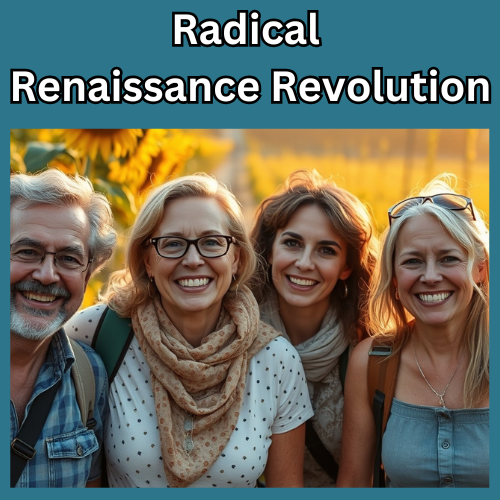How Holding Space Creates Room for Breakthroughs
My article The Strategic Void: The Professional’s Guide to Mind-Clearing Breakthroughs, made me think of the concept of “holding space,” which prompted the writing of this post.
The concept of “holding space” is a powerful complement to the idea of strategic emptiness. While strategic emptiness involves intentionally creating gaps in your schedule or environment to foster creativity and reflection, holding space focuses on the interpersonal aspect of creating that same supportive emptiness for others. It involves creating a safe, non-judgmental, and supportive environment where people can freely express themselves, explore their thoughts and feelings, and often find new insights or solutions.
During my Camino de Santiago retreats, I do both: I hold space and I create strategic emptiness for my guests – although similar, it is two different concepts. In the article I mentioned above, I discussed strategic emptiness. Below, I talk about “holding space” in relation to creating emptiness.
What is Holding Space?
Holding space is the act of being fully present and attentive to another person or group, to the exclusion of your own agenda, needs, and distractions. It’s about creating a container of acceptance and understanding, allowing them to express themselves without interruption or judgment. It involves several key elements:
- Active Listening: This goes beyond simply hearing the words someone is saying. Active listening means fully focusing on the speaker, paying attention to both their verbal and non-verbal cues. It involves making eye contact (when culturally appropriate), nodding, and offering brief verbal affirmations like “I see” or “Tell me more.” It also means resisting the urge to interrupt, offer unsolicited advice, or formulate your response while the other person is still speaking. Stephen Covey’s “Seek first to understand, then to be understood” encapsulates this principle.
- Emotional Presence: Holding space requires you to be aware of and acknowledge the emotions being expressed. This means recognizing that emotions are valid and important, even if they differ from your own. It involves empathy – the ability to put yourself in another person’s shoes and understand their feelings. You might reflect back what you’re hearing, such as, “It sounds like you’re feeling frustrated” or “I sense that this is bringing up a lot of sadness for you.”
- Non-Judgment: This is perhaps the most crucial aspect of holding space. It means creating a safe space where people feel free to be themselves without fear of criticism, rejection, or evaluation. It involves suspending your own opinions, beliefs, and biases, and accepting the other person exactly as they are. It’s about recognizing that everyone’s experiences and perspectives are unique and valid, even if you don’t agree with them.
- Compassion: Holding space is rooted in compassion, a deep awareness of the suffering of another, coupled with a desire to alleviate it. It involves offering kindness, understanding, and support, without trying to fix the person or their situation. Compassion recognizes that everyone is doing the best they can, given their circumstances.
- Respect: Holding space means valuing the other person’s thoughts, feelings, and experiences. It involves treating them with dignity and respect, regardless of their background, beliefs, or behavior. It’s about recognizing their inherent worth and humanity.
- Trust: Holding space requires building trust. The person sharing needs to feel safe that what they say will be kept confidential and that they won’t be judged or ridiculed. This trust creates the foundation for vulnerability and openness.
- Patience: Holding space often requires patience. People process information and emotions at different speeds. It’s important to allow the person the time they need to express themselves fully, without rushing them or interrupting their flow.
- Humility: Holding space is not about being the expert or having all the answers. It’s about recognising that the other person is the expert on their own experience. It requires humility to step back, listen, and allow them to find their own way.
How Holding Space Fits into Strategic Emptiness
When combined with strategic emptiness, holding space can enhance both your own creative process and the collaborative efforts of a team. Here are several ways they intersect:
- Facilitating Breakthroughs in Others: When you practice holding space, you create an environment where others feel comfortable sharing their ideas and insights, even if they seem unconventional or vulnerable. This can lead to breakthroughs that might not have emerged in a busier or more distracting setting. By being fully present and attentive, you allow others to tap into their own “inner” strategic emptiness – that quiet space within where intuition and creativity reside. You’re essentially creating the external conditions that mirror the internal state needed for insight.
- Enhancing Team Collaboration: In a professional context, holding space can significantly improve team dynamics and collaboration. When team members feel safe to express their thoughts and ideas without fear of judgment or criticism, they are more likely to engage in open and honest communication. This can lead to more innovative solutions, stronger problem-solving, and a greater sense of unity and psychological safety within the team. It fosters a culture where diverse perspectives are valued and where people feel empowered to take risks and share their authentic selves.
- Supporting Personal Growth: By providing a supportive emptiness, you enable others to explore their challenges, aspirations, and vulnerabilities more deeply. This can lead to greater self-awareness, emotional processing, and personal breakthroughs. Holding space allows individuals to confront difficult emotions, gain clarity on their situations, and discover their own inner strength and resilience. It’s about empowering them to navigate their own journey of growth and transformation.
- Creating a Culture of Strategic Emptiness: When leaders and individuals within a team practice holding space, they model the importance of strategic emptiness. This can create a broader organisational culture where taking time for reflection, silence, and creative exploration is valued and encouraged. Over time, this can lead to a more innovative, adaptable, and resilient organisation. It becomes part of the organisational DNA, influencing how people interact, communicate, and approach their work.
A Spell-Binding Anecdote: The Transformation in the Circle
I once facilitated a weekend retreat for a group of social workers who were experiencing burnout and compassion fatigue. They were exhausted, cynical, and felt deeply disconnected from their sense of purpose.
On the first evening, we gathered in a circle around a simple, unadorned space. I explained the concept of holding space and invited them to share, one at a time, what had brought them to the retreat and what they were hoping to gain. I emphasised that there were no expectations, no right or wrong answers, and that they were free to share as much or as little as they felt comfortable with.
The first few people spoke haltingly, their voices filled with pain and frustration. They talked about the overwhelming demands of their jobs, the constant exposure to trauma, and the feeling that they were making little difference. As I listened, I focused on being fully present, making eye contact, and acknowledging their emotions with simple, non-judgmental responses. I held the space for their vulnerability, their anger, and their sadness.
As the circle progressed, something remarkable began to happen. The act of being truly heard, without interruption or judgment, seemed to create a palpable shift in the atmosphere. People started to open up more deeply, sharing stories they had never told anyone before. There were tears, moments of silence, and occasional laughter. The shared vulnerability created a powerful sense of connection and empathy.
One woman, Sarah, a usually stoic and reserved social worker, began to speak about a particularly difficult case involving a child in severe neglect. As she described the child’s suffering, her voice cracked, and she started to cry. The other members of the circle listened in silence, their faces filled with compassion. No one offered advice or tried to fix her pain. They simply held the space for her grief.
Sarah continued to speak, her tears flowing freely. As she spoke, it was as if she was releasing a burden she had been carrying for a long time. When she finally finished, there was a profound silence in the room. Then, another woman reached out and gently took Sarah’s hand. “Thank you for sharing,” she said softly. “We’re here with you.”
In that moment, something shifted in Sarah. She looked up, her eyes filled with a mixture of sadness and relief. “I feel…lighter,” she said, her voice barely a whisper. “I didn’t realize how much I was holding onto.”
Over the course of the weekend, the transformation in that circle was palpable. As the social workers continued to share their stories and experiences, they began to reconnect with their sense of purpose and find new sources of strength and resilience. The act of holding space had created a container of safety and acceptance, allowing them to tap into their own inner resources and find healing in their shared humanity. The emptiness of judgment and interruption allowed their own wisdom and capacity for healing to emerge.
This anecdote illustrates the power of holding space to facilitate deep personal transformation and connection. It demonstrates how creating a supportive and non-judgmental environment can allow individuals to process difficult emotions, gain new insights, and discover their own resilience. It’s a reminder that sometimes, the most powerful thing we can do for another person is simply to be present, to listen, and to hold the space for their experience, allowing them to fill the emptiness.
Practical Applications
The principles of holding space can be applied in a wide range of settings, including:
- Team Meetings: Start meetings with a brief period of silence or use open-ended questions to invite team members to share their thoughts and insights freely. Encourage active listening and create a culture where everyone feels safe to express their opinions, even if they differ from the majority.
- One-on-One Conversations: When having one-on-one discussions, whether with a colleague, friend, or family member, practice active listening and emotional presence. Put aside distractions, make eye contact, and focus on truly understanding the other person’s perspective. Resist the urge to interrupt or offer unsolicited advice.
- Therapy and Counselling: Therapists and counsellors are trained to hold space for their clients, providing a safe and supportive environment for them to explore their emotions and work through their challenges.
- Coaching and Mentoring: Coaches and mentors can use holding space to empower their clients or mentees to identify their goals, overcome obstacles, and develop their full potential.
- Facilitation: Facilitators use holding space to create inclusive and participatory group processes, where all voices are heard and valued.
- Conflict Resolution: Holding space is essential in conflict resolution, where it can help individuals to communicate their needs and feelings in a safe and respectful manner, and to find common ground.
- Spiritual Practices: Many spiritual traditions incorporate practices that involve holding space, such as meditation, prayer, and silent retreats.
- End-of-Life Care: Holding space is a crucial aspect of end-of-life care, where it involves providing comfort, support, and presence to the dying person and their loved ones.
Integrating Holding Space with Strategic Emptiness
To effectively integrate holding space with strategic emptiness, consider these guidelines:
- Create Safe Environments: Whether in meetings, one-on-one conversations, or larger gatherings, consciously cultivate a space that feels safe, welcoming, and non-judgmental. This might involve setting ground rules for respectful communication, ensuring confidentiality, and creating a physical environment that promotes openness and comfort.
- Practice Active Listening: Make a conscious effort to fully focus on the person speaking, both verbally and non-verbally. Pay attention to their body language, tone of voice, and the emotions they are expressing. Ask clarifying questions, reflect back what you’re hearing, and resist the urge to interrupt or formulate your response while they are still speaking.
- Cultivate Emotional Presence: Be aware of your own emotions and how they might be affecting your ability to hold space for others. Practice empathy and try to understand the other person’s feelings, even if they differ from your own. Acknowledge their emotions without judgment or dismissal.
- Encourage Reflection: Allow time for silence and open-ended questions to facilitate deeper thinking and self-reflection. Avoid the temptation to fill every moment with words. Create space for the other person to process their thoughts and emotions at their own pace.
- Suspend Judgment: Consciously suspend your own opinions, beliefs, and biases. Accept the other person exactly as they are, without trying to fix them, change them, or evaluate them. Recognise that their experiences and perspectives are valid, even if you don’t agree with them.
- Model the Behaviour: As a leader, facilitator, or simply as a friend or colleague, practice creating emptiness and holding space yourself, and encourage others to do the same. By modelling these behaviours, you can help to create a culture where they are valued and integrated into everyday interactions.
- Be Mindful of Power Dynamics: Recognise that power imbalances can affect how safe someone feels in sharing. If you are in a position of authority, take extra care to create a level playing field and ensure that everyone’s voice is heard and respected.
- Know Your Limits: Holding space can be emotionally demanding. It’s important to be aware of your own limits and to practice self-care. If you’re feeling overwhelmed or depleted, it’s okay to take a break or to seek support for yourself.
- Trust the Process: Holding space requires trust–trust in the other person’s ability to find their own way, and trust in the power of the process itself. Let go of the need to control the outcome, and allow the other person’s journey to unfold naturally.
By integrating holding space with strategic emptiness, you can create a powerful synergy that fosters creativity, innovation, and personal growth, both for yourself and for those you interact with. It’s a practice that cultivates deeper connections, enhances collaboration, and empowers individuals to navigate their challenges and discover their full potential.

Ready to start again, stronger than ever before? This quiz will help you find out. It is not just about measuring where you are right now; it’s about shining a light on the areas of your life that feel meaningful, as well as those that might need attention. It’s an opportunity to reflect, recalibrate, and take steps toward a life that’s not only successful but profoundly fulfilling. Take The Quiz
If you’re feeling overwhelmed, exhausted, or on the edge of burnout, you need immediate support. The Road Map to Resilience: Burnout to Brilliance online course (with the option of adding coaching sessions) is designed for exactly that: a practical, step-by-step course to help you regain control, rebuild your energy, and find clarity in the chaos. This isn’t a quick fix—it’s about proven strategies to calm your nervous system, shift your mindset, and create sustainable resilience. No need to cope with this on your own—let’s get you back on track.


“I am an experienced medical doctor – MBChB, MRCGP, NLP master pract cert, Transformational Life Coach (dip.) Life Story Coach (cert.) Stress Counselling (cert.) Med Hypnotherapy (dip.) and EAGALA (cert.) I may have an impressive number of letters after my name, and more than three decades of professional experience, but what qualifies me to excel at what I do is my intuitive understanding of my clients’ difficulties and my extensive personal experience of managing major life changes using strategies I developed over many years.” Dr M Montagu

